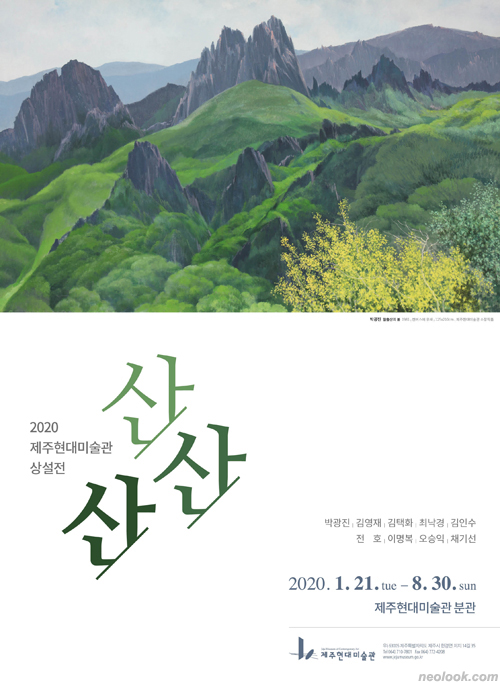- ● homepage
- ● archives
- ● restoration
- ● books
- ● big banners
- ● post board
- ■ neo's search
- ■ about us
- ■ 게재방법 안내
- 개인정보처리방침

- [email protected]
- Tel. 02_335_7922
- Fax. 02_335_7929
- 10:00am~04:30pm
- 월요일~금요일
- 3/3(월) 대체공휴일

산, 산, 산
Mountain, Mountain, Mountain展 2020_0121 ▶ 2020_0830 / 월요일 휴관
별도의 초대일시가 없습니다.
참여작가 박광진_김영재_김택화_최낙경 김인수_전호_이명복_오승익_채기선
관람료 성인 2,000원(단체 1,400원) / 어린이_500원(단체 300원) 청소년,군인 1,000원(단체 700원) / 단체_10인 이상 6세 이하,65세 이상,장애인 등 무료관람
관람시간 / 09:00am~06:00pm / 7~8월_09:00am~07:00pm / 월요일 휴관
제주현대미술관 JEJU MUSEUM OF CONTEMPORARY ART 제주도 제주시 한경면 저지14길 35 분관 Tel. +82.(0)64.710.7806 www.jejumuseum.go.kr
『산, 산, 산』展은 제주 현대미술관이 2020년 첫 전시로 마련한 상설전이다. 제주 현대미술관 분관에서 열리는 이번 전시는 우리나라 명산의 풍경을 담은 박광진의 기증 작품 8점과 현대미술관과 기당미술관 소장품 중 산을 소재로 한 작품 8점을 소개한다. ● 인간의 삶과 함께 해 온 산은 작가들에게도 매력적인 화제(畫題)로 작용하여, 동서고금을 막론하고 많은 작품에 등장해왔다. 이는 단순히 물리적 공간으로서의 산을 넘어 정신, 문화적 영역까지 인간사와 관계된 점과도 관련되어 있을 것이다. 우리에게는 한국의 산천을 소재로 하는 실경산수화의 오랜 전통이 있고 근대 서양화 도입 이후, 많은 작가들이 서양의 재료인 유화를 통해 한국의 풍토를 화폭에 담아 온 풍경화의 역사가 있다. 급변하는 시대를 살아가는 현대인들에게 같은 자리에 존재하는 것만으로 안정감을 주며 안전 기지로서의 역할을 다하고 있는 산에 대한 관심과 애착은 후세대인 동시대 작가들에게도 여전히 유효하다.
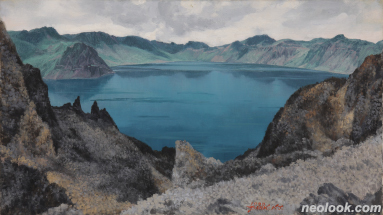
- 박광진_백두천지_캔버스에 유채_130.3×193.9cm_1983
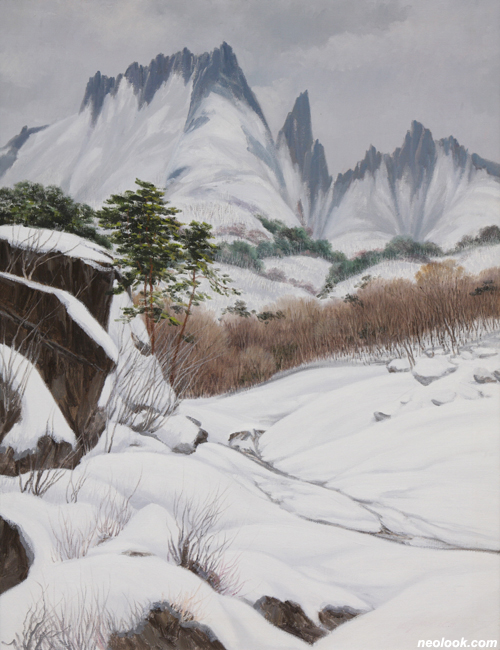
- 박광진_설악2_캔버스에 유채_116×91cm_1987
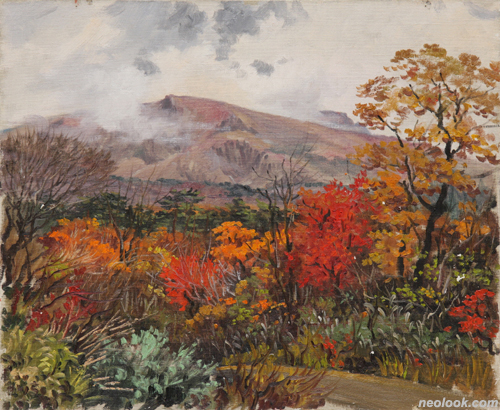
- 박광진_영실추경_캔버스에 유채_50×60.6cm_1993
두 섹션으로 나뉜 이번 전시의 1층 공간은 박광진의 기증작품으로 구성하였다. 박광진(1935~)은 한국 현대 화단에서 구상미술의 발전과 함께해 온 대표적 작가이다. 1950년대 이후 본격적으로 한국 화단에 유입된 서구 미술의 영향으로 많은 동료 작가들이 앵포르멜, 모노크롬 계열의 추상회화에 몰두할 때에도 박광진은 일관되게 자연의 충실한 재현에 근거한 사실주의 화풍을 견지하였다. 약 60여 년에 이르는 작품 활동 기간 동안 정물, 인물, 풍경 등 다양한 소재를 다루어 왔지만 그중 대다수는 풍경을 소재로 한 작품으로 우리 산천에 대한 애정을 근거로 한 한국적 풍경의 상을 제시해 왔다. 이번 전시에서는 여행을 좋아하는 활달한 성정답게 작가가 제주, 전라도, 강원도, 함경도 등 우리나라 전역을 여행 다니며 포착한 한라산, 월출산, 백두산, 설악산의 사시사철 풍경을 볼 수 있다. 풍요로운 가을 정취의 한라산과 생명 가득한 월출산의 봄, 백두산 천지의 성스러운 기운 등 작품 속 화면은 사생에 근거한 사실적인 형과 색의 표현으로 시간과 계절에 따른 산천의 풍토가 생생하다.
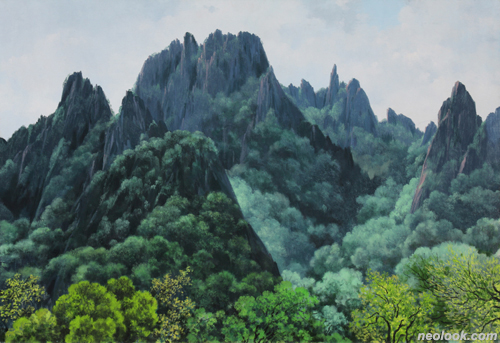
- 박광진_월출산 여름_캔버스에 유채_130.3×193.9cm_1990
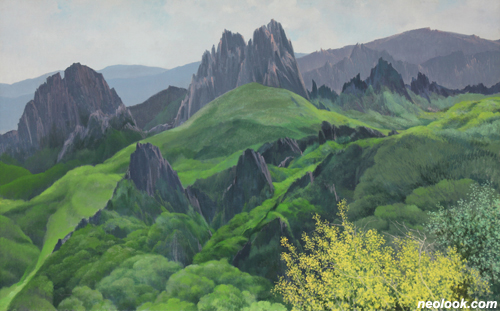
- 박광진_월출산의 봄_캔버스에 유채_125×210cm_1981
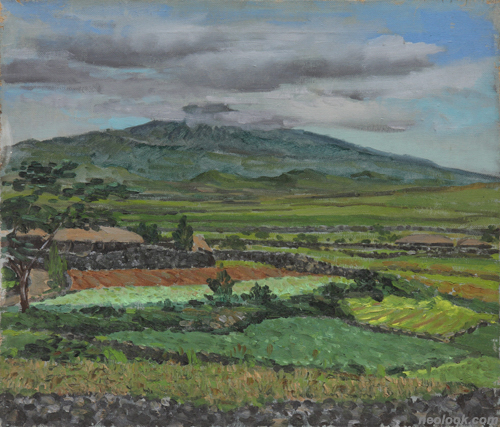
- 박광진_한라산_캔버스에 유채_45.5×53cm_1990
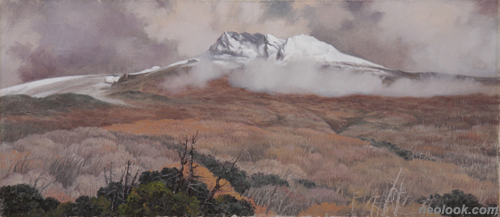
- 박광진_한라의 가을_캔버스에 유채_40×92cm_1973
2층 공간은 본 전시 주제인 '산'을 보다 풍성히 보여주기 위해 제주 현대미술관 소장품인 전호, 이명복, 오승익의 작품과 제주 최초의 공립미술관인 기당미술관 소장품 김영재, 김택화, 최낙경, 김인수, 채기선의 작품으로 이루어져 있다. 수채화 기법으로 깊고 높은 산을 군더더기 없이 간결하게 표현한 전호의 산, 세밀한 필치, 청색과 황색의 보색 사용과 함께 수평적 구도가 강조된 이명복의 맑은 가을철 한라산 풍경, 황톳빛 화면으로 옛 기억을 소환하는 오승익의 장중한 한라산, 단순한 조형미의 푸른 산의 그림으로 잘 알려진 김영재(Kim Young-zai)가 포착한 1970년대의 고즈넉한 정경의 한라산, 화면 가득한 눈 내린 나무들로 옛 한라산의 숲길을 추억할 수 있는 김택화의 한라산 설경, 윤곽선으로 강조된 중첩된 산과 맑은 공기가 공존하는 최낙경(Choi Nak-kyeong)의 북한산 정경, 표현적 필치와 밝은 색감으로 눈 쌓인 아침 풍경을 감각적으로 표현한 김인수의 한라산, 심상 속의 풍경을 붉고 노란 기운의 신비스러운 이미지로 제시한 채기선의 한라산 등의 이번 전시 작품들은 산의 고유한 정취를 느끼기 충분하며 향수 어린 옛 기억의 풍경을 소환한다.

- 전호_산_종이에 수채_75×100cm_2000
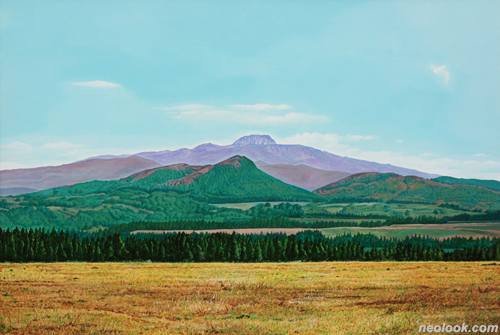
- 이명복_10월의 한라산_캔버스에 아크릴채색_89×130cm_2009

- 오승익_흔적, 기억-한라산_캔버스에 아크릴채색, 혼합재료_130×162cm_2012
구상미술의 매력은 난해한 여타의 현대미술과 달리 애쓰지 않아도 감각적으로 작품과 쉽게 소통할 수 있다는 점이다. 구상미술의 미학적 특징과 함께 이번 전시에서는 작가들이 자연을 바라보는 관점과 그 표현 양상이 얼마나 다채로운지 새삼 느낄 수 있으며, 약 40년을 아우르는 다른 세대의 작가들이 포착한 1970년대부터 2000년대의 산 풍경을 통해 구상미술의 어제와 오늘을 살필 수 있다. ● 일상의 전자 기기에서 자유롭지 못한 오늘날의 삶에서 만나게 되는 우리나라의 명산 그림들은 마치 오랜만에 흙을 손으로 만졌을 때 느낄 수 있는 살아 있다는 생생한 감각을 되돌려 준다. 산이 본래 인간에게 식량과 기운, 여가 등 인간다운 삶을 위해 모든 것을 내어주는 장소였듯 작품으로나마 만나는 산을 통해 풍만한 위안과 기운을 안고 갈 수 있는 시간이 될 것이다. ■ 제주현대미술관
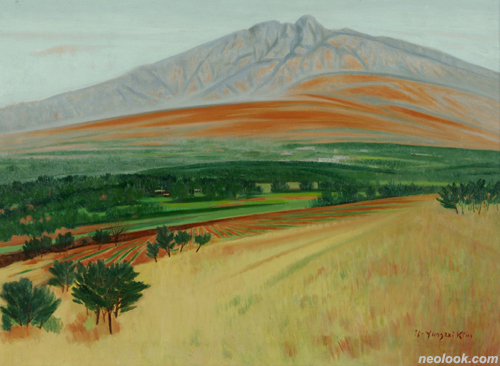
- 김영재_한라산_캔버스에 유채_51×71cm_1978_기당미술관 소장품

- 김택화_한라산 설경_캔버스에 유채_53×65.1cm_1974_기당미술관 소장품
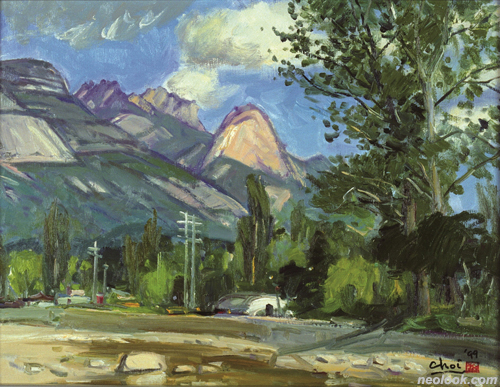
- 최낙경_북한산_캔버스에 유채_41×53cm_1999_기당미술관 소장품
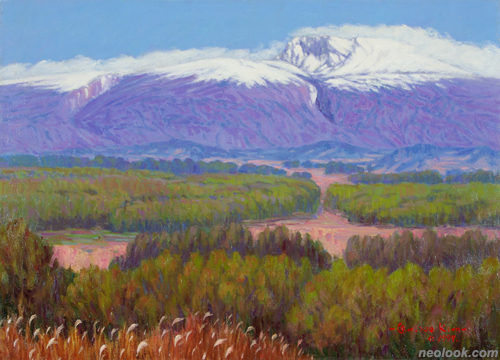
- 김인수_한라산의 아침_캔버스에 유채_53×72.7cm_1999_기당미술관 소장품
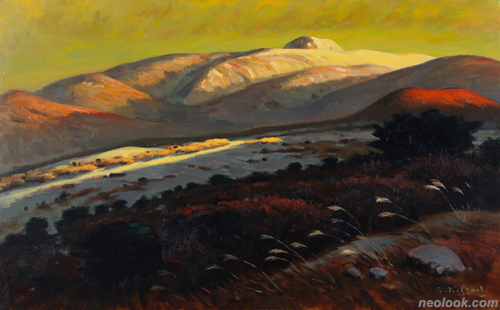
- 채기선_한라산_캔버스에 유채_80.3×116.8cm_2003
『Mountain, Mountain, Mountain』is the first exhibition of 2020 at Jeju Museum of Contemporary Art. Held in the annex of Jeju Museum of Contemporary Art, the exhibition introduces 8 works depicting famous Korean mountains, created and donated by Park Gwang-jin. Eight additional mountain landscape works are displayed from the collections of Jeju Museum of Contemporary Art and Gi-dang Art Museum. ● Mountains, which are so central to human life, have long been attractive subject matter for artists and appear in numerous artworks across time and space. This is probably because they are related to human history and reach the spiritual and cultural realm beyond physical space. Koreans have a long tradition of viewing actual landscapes, and after modern Western painting was introduced, many artists have depicted Korean landscapes using the Western material of oil paints. For modern people who are living in a rapidly changing era, mountains provide a sense of stability and represent a foundation of safety. In this respect, the affection and interest of contemporary artists in mountains remain valid. ● This exhibition is divided into two parts. On the first floor, Park Gwang-jin's donated works are displayed. Park Gwang-jin (b. 1935) is a leading artist in the development of figurative art in the Korean modern art world. As Western art rushed into the Korean art world from the 1950s, and numerous artists came under the influence of abstract painting affiliated with Informel or monochrome, Park Gwang-jin consistently adhered to realistic representations and the faithful reproduction of nature. Over approximately 60 years of activity in the art world, he has portrayed diverse subject matter such as still life, human figures, and landscapes; however, most of his works are landscapes and representations of the Korean landscape with an affection for Korean nature. Due to his active personality as a travel lover, the landscapes of Mt. Halla, Mt. Wolchul, Mt, Seorak, and others are represented across four seasons after he traveled across the country including Jeju-do, Jeolla-do, Gangwon-do, and Hamgyeong-do. As seen in the paintings of Mt. Halla, which is full of autumn sentiment, Mt. Wolchull, which is full of life, and the sacred energy of Cheonji lake at Mt. Baekdu, the mountains are depicted in realistic form and color based on sketches of nature that are vividly and authentically represented according to the season. ● On the second floor, to more fully explore the 'Mountain' theme of this exhibition, works from the collection of Jeju Museum of Contemporary Art by artists Jeon Ho, Lee Myoung-bok, and Oh Seong-ik are displayed alongside works by Kim Young-zai, Kim Tek-hwa, Choi Nak-kyeong, Kim in-su, and Chae Gi-seon from the collection of Gi-dang Art Museum, Jeju's first public art museum. The works include: Jeon Ho's deep and high mountain, simply depicted without over-elaboration using a watercolor technique; Lee Myoung-bok's clear Mt. Halla landscape in fall with its elaborate brushstrokes, complementary blue and amber colors and horizontal composition; Oh Seung-ik's solemn Mt. Halla which evokes nostalgic memories with its reddish-brown color; the lonely landscape of Mt. Halla in the 1970s captured by Kim Young-zai who is renowned for blue mountain paintings with simple formative beauty; a snowy Mt. Halla landscape by Kim Tek-hwa, evoking memories of old forest paths with trees covered with snow; Choi Nak-kyeong's Mt. Bukhan landscape which emphasizes the overlapping mountains and clear air with contour lines; Kim in-su's Mt. Halla, depicting a snowy morning landscape with expressive brushstrokes and bright colors; and Chae Gi-seon's landscape of Mt. Halla with its mystical imagery using yellowish and reddish colors. The works displayed for this exhibition allow viewers to feel the distinct sentiments of mountains, evoking landscapes deep within our nostalgic memories. ● The attraction of figurative art lies in the fact that, unlike modern art, viewers can easily appreciate and sensuously communicate with it. Alongside the aesthetic features of figurative art, this exhibition will provide an opportunity for viewers to appreciate the diverse perspectives the artists have about nature in addition to their diverse expressive aspects. In addition, viewers can explore the yesterday and today of figurative art through mountain landscapes captured from the 1970s to the 2000s by artists over 40 years and across generations. ● To people who are enthralled to electronic devices in their daily lives, paintings of Korea's famous mountains will evoke the vivid sense of directly touching the very soil after such a long time. As mountains have long provided everything for human life such as food, energy, leisure and more, the mountains encountered through these artworks will provide visitors with solace and energy. ■ Jeju Museum of Contemporary Art
Vol.20200121a | 산, 산, 산展

